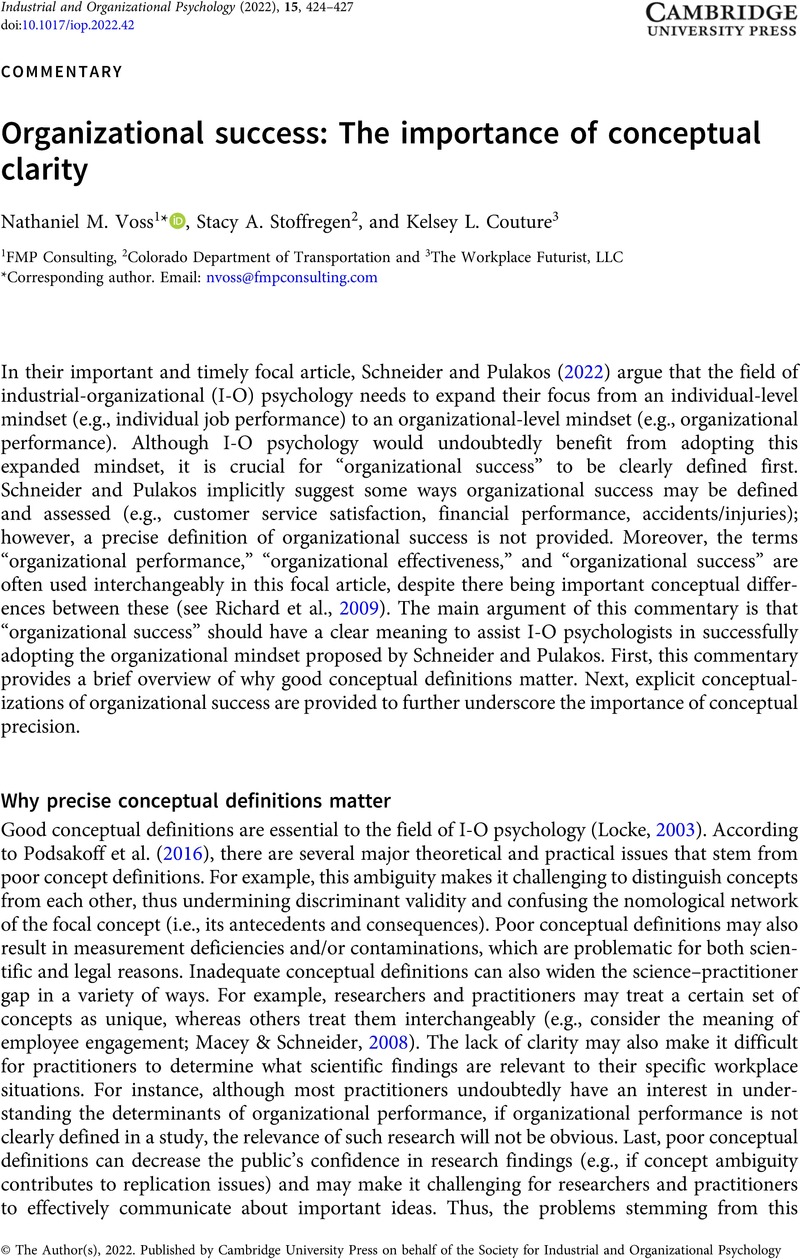No CrossRef data available.
Article contents
Organizational success: The importance of conceptual clarity
Published online by Cambridge University Press: 09 September 2022
Abstract
An abstract is not available for this content so a preview has been provided. Please use the Get access link above for information on how to access this content.

- Type
- Commentaries
- Information
- Copyright
- © The Author(s), 2022. Published by Cambridge University Press on behalf of the Society for Industrial and Organizational Psychology
References
Alford, J. (2002). Defining the client in the public sector: Asocial-exchange perspective. Public Administration Review, 62(3), 337–346.CrossRefGoogle Scholar
Crook, T. R., Todd, S. Y., Combs, J. G., Woehr, D. J., & Ketchen, D. J. Jr. (2011). Does human capital matter? Ameta-analysis of the relationship between human capital and firm performance. Journal of Applied Psychology, 96(3), 443–456.CrossRefGoogle Scholar
Gonzalez-Mulé, E., Mount, M. K., & Oh, I.-S. (2014). A meta-analysis of the relationship between general mental ability and nontask performance. Journal of Applied Psychology, 99(6), 1222–1243.CrossRefGoogle ScholarPubMed
Locke, E. A. (2003). Good definitions: The epistemological foundation of scientific progress. In Greenberg, J. (Ed.), Organizational behavior, state of the science (pp. 415–444). Lawrence Erlbaum Associates.Google Scholar
Locke, E. A. (2012). Construct validity vs. concept validity. Human Resource Management Review, 22(2), 146–148.CrossRefGoogle Scholar
Macey, W. H., & Schneider, B. (2008). The meaning of employee engagement. Industrial and Organizational Psychology: Perspectives on Science and Practice, 1(1), 3–30.Google Scholar
Parhizgari, A. M., & Gilbert, G. R. (2004). Measures of organizational effectiveness: Private and public sector performance. Omega, 32(3), 221–229.CrossRefGoogle Scholar
Ployhart, R. E. (2012). The psychology of competitive advantage: An adjacent possibility. Industrial and Organizational Psychology: Perspectives on Science and Practice, 5(1), 62–81.CrossRefGoogle Scholar
Ployhart, R. E., & Hale, D. Jr. (2014). The fascinating psychological microfoundations of strategy and competitive advantage. Annual Review of Organizational Psychology and Organizational Behavior, 1(1), 145–172.CrossRefGoogle Scholar
Podsakoff, P. M., MacKenzie, S. B., & Podsakoff, N. P. (2016). Recommendations for creating better concept definitions in the organizational, behavioral, and social sciences. Organizational Research Methods, 19(2), 159–203.Google Scholar
Pulakos, E. D., Kantrowitz, T., & Schneider, B. (2019). What leads to organizational agility: It’s not what you think. Consulting Psychology Journal: Practice and Research, 71(4), 305–320.CrossRefGoogle Scholar
Richard, P. J., Devinney, T. M., Yip, G. S., & Johnson, G. (2009). Measuring organizational performance: Towards methodological best practice. Journal of Management, 35(3), 718–804.CrossRefGoogle Scholar
Schneider, B., & Pulakos, E. P. (2022). Expanding the I-O psychology mindset to organizational success. Industrial and Organizational Psychology: Perspectives on Science and Practice, 15(3), 385–402.CrossRefGoogle Scholar
Singh, S., Darwish, T. K., & Potočnik, K. (2016). Measuring organizational performance: Acase for subjective measures. British Journal of Management, 27(1), 214–224.CrossRefGoogle Scholar
Wallace, S. R. (1965). Criteria for what? American Psychologist, 20(6), 411–417.CrossRefGoogle Scholar




